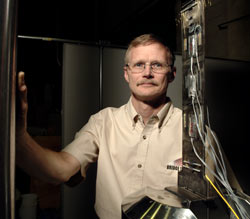Inside Iowa State
Inside ArchivesSubmit newsSend news for Inside to inside@iastate.edu, or call (515) 294-7065. See publication dates, deadlines. About InsideInside Iowa State, a newspaper for faculty and staff, is published by the Office of University Relations. |
May 18, 2006 Wood: A combination of strength and structureby Mike Krapfl Bridge engineers figured they'd need 640,000 pounds of pressure to test the limits of the latest in concrete beam technology. But where can you find a load like that on the Iowa State campus? The person to ask is Doug Wood, a wiry 51-year-old who knows a few things about testing and demonstrating the limits of strength. In the case of a 71-foot bridge beam made of ultra-high performance concrete, Wood can rig hydraulic actuators on a steel rack so they push down with incredible force. An experiment in Iowa State's Structural Engineering Research Laboratory last summer forced 595,000 pounds of load on the beam before it failed with a loud pop and a long diagonal crack. 
Doug Wood Then there's Wood's experience as a Cyclone athlete. He competed as a gymnast and won national titles on the still rings as a junior and senior in 1976 and 1977. He also earned All-America honors those two years. "One of his key characteristics was his amazing strength," said Ed Gagnier, coach of the Cyclones' men's gymnastics team from 1961 to 1983. "He was extremely proficient at strength moves and also had perfect execution. That combination was pretty hard to beat." And so Gagnier said it's no real surprise Wood has made a career out of testing the strength of beams and structures. "He's a good one for that," Gagnier said. "From muscle strength to molecular strength." A Cyclone gymnastWood became a gymnast when he was cut from the basketball team at Hinsdale Central High School in the Chicago suburbs. It was a good thing for the gymnastics team. Hinsdale Central won state championships all four years Wood was on the team. And Gagnier said Wood was a key part of the team's success. "I knew he was Cyclone material," Gagnier said. So the coach went to work recruiting Wood to Iowa State. Wood said it was gymnastics (he was offered a partial scholarship) and architecture that brought him to campus. It was a combination that kept him as busy as any Cyclone. He was in class from 8 to 3. He was working out with the gymnastics team from 3 to 6. And he was studying architecture till 1 or 2 in the morning. After four years of that, Wood decided architecture wasn't what he really wanted to do. He wanted to get beyond designing structures. He wanted to get his hands on structures. He decided to go ahead and get that architecture degree in 1978. Then he continued at Iowa State by studying structural engineering in graduate school. Wood's gymnastics career helped him in Iowa State's engineering classrooms. "Gymnasts and engineers are very exact," Wood said. "They try to be perfect and as efficient as possible." The structures labWood's graduate career included work in Iowa State's structures laboratory in the department of civil, construction and environmental engineering. As research projects picked up, he took a job as lab supervisor and eventually moved up to manager. The 6,900-square-foot lab on the southwest side of the Town Engineering Building tests building and bridge structures for strength and helps researchers find ways to make structures safer, stronger and more efficient. A lot of the testing takes structures to their limits. "We break a lot of things," Wood said. There's a lot of demand for that kind of work. So Wood is working this summer to open a second structures lab on the northwest side of Town Engineering. The second lab will handle smaller projects that don't require the million-pound capacity of the floor in the original lab. Terry Wipf, Iowa State's Pitt-Des Moines Professor in Civil Engineering and director of Iowa State's Bridge Engineering Center, said it's important to have somebody like Wood around the labs and in the field. "Doug has a unique background," Wipf said. "He's somebody that enjoys working with real structures and getting his hands dirty. And he has technical training. He's a perfect fit for that job." And what about Wood's background as a national champion gymnast? Does Wipf know anything about that? He sure does. "But it was probably another faculty member who told me," Wipf said. "It was not Doug." Still more to learnThere's a lot more to researching the breaking point of a bridge beam than putting 200-ton capacity hydraulic actuators to work. Take last summer's test of the ultra-high performance concrete beam. That beam was built with fiber optic strain gauges inside. The gauges work by transmitting light through glass fibers. Every strain on the fibers changes the light that's reflected back. A black box records the changes and, therefore, the strains. The system can take up to 250 measurements every second. The result is a lot of data to help engineers understand just how the innovative concrete responds to heavy loads. Other lab projects these days involve testing a popular concept in highway building and repair called accelerated construction. The idea is to find innovative techniques and technologies that make it possible to speed up projects while extending the useful lives of roads and bridges. When you visit Wood's office to talk about all of that lab work, you'll find his desk surrounded by new sensors, multiplexers and data loggers. Wood knows how to use each of them. And that's why he likes his job in the structures lab. Sure, he gets to break things. But he also gets to learn things. |
SummaryDoug Wood, who is manager of the structural engineering research laboratory, was an All-American gymnast for the Cyclones. Quote"Gymnasts and engineers are very exact," Wood said. "They try to be perfect and as efficient as possible." Doug Wood |